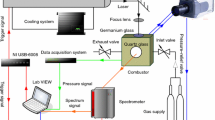Abstract
Boron was chosen as fuel owing to its excellent thermodynamic values for combustion. The difficulty of the boron in combustion is the formation of a surface oxide layer, which postpones the combustion process, reducing the performance of the rocket engine. In this paper, magnesium boride was sintered as high-energy fuel as a substitute for boron. The combustion heat and efficiency of magnesium boride and boron were determined using oxygen bomb calorimeter. The combustion characteristics of magnesium boride were investigated by thermal analysis, chemical analysis, XRD, and EDS. Results show that the combustion performance of magnesium boride are better than that of amorphous boron in oxygenated environments. The evaporation of magnesium in magnesium boride combustion process prevent the formation of a closed oxide layer, leading to higher combustion efficiency.





Similar content being viewed by others
References
King MK. Ignition and combustion of boron particles and clouds. J Spacecraft. 1982;19:294–306.
Kuo KK. Combustion of boron-based solid propellants and solid fuels. Boca Raton: CRC Press; 1993.
Liu TK, Luh SP, Perng HC. Effect of boron particles surface coating on combustion of solid propellants for ducted rockets. Propellants, Explos, Pyrotech. 1991;16:156–66.
Yeh CL. Ignition and combustion of boron particles. The Pennsylvania State University, Ph.D Thesis; 1995.
Hsia H. Air-augmented combustion of boron and boron-metal alloys. Air Force Research Lab, Final Rept, AFR DL-TR-71-80; 1971.
Mestwerdt R, Selzer H. Experimental investigation of boron/lithium combustion. AIAA J. 1975;14:100–2.
Schoenitz M, Drezin EL, Shtessel E. Constant volume explosions of aerosols of metallic mechanical alloys and powder blends. J Propuls Power. 2003;19:405–12.
Mota JM, Abenojar J, Martinez MA, Velasco F, Criado AJ. Borides and vitreous compounds sintered as high-energy fuels. J Solid State Chem. 2004;177:619–27.
Nagamatsu J, Nakagawa N, Muranaka T, Zenitani Y, Akimitsu J. Superconductivity at 39 K in magnesium diboride. Nature. 2001;410:63–4.
Chądzyński GW, Staszczuk P, Sternik D, Blachnio M. Studies of physico-chemical properties and fractal dimensions of MgB2 superconductor surface. J Therm Anal Calorim. 2012;108:985–9.
Yan SC, Yan G, Liu CF, Lu YF, Zhou L. Experimental study on the phase formation for the Mg-B system in Ar atmosphere. J Alloys Compd. 2007;437:298–301.
Lee S. Crystal growth of MgB2. Physica C. 2003;385:31–41.
Fan ZY, Hinks DG, Newman N, Rowell JM. Experimental study of MgB2 decomposition. Appl Phys Lett. 2001;79:87–9.
Brutti S, Ciccioli A, Balducci G, Gigli G. Vaporization thermodynamics of MgB2 and MgB4. Appl Phys Lett. 2002;80:2892–4.
Brutti S, Balducci G, Gigli G, Ciccioli A, Manfrinetti P, Palenzona A. Thermodynamic and kinetic aspects of decomposition of MgB2 in vacuum: implication for optimization of synthesis conditions. J Cryst Growth. 2006;289:578–86.
Spear KE. Phase diagrams of binary Mg-alloys. Materials Park, Ohio: ASM International; 1988.
Liu ZK, Zhong Y, Schlom DG, Xi XX, Li Q. Computational thermodynamic modeling of the Mg-B system. Calphad. 2001;25:299–303.
Liu ZK, Schlom DG, Li Q, Xi XX. Thermodynamics of the Mg-B system: implications for the decomposition of MgB2 thin films. Appl Phys Lett. 2001;78:3678–80.
Moiseev GK, Ivanovskii AL. Thermodynamic properties and thermal stability of magnesium borides. Inorg Mater. 2005;41:1061–6.
Kim S, Stone DS, Cho JI, Kang CS, Bae JC. Phase stability determination of the Mg-B binary system using the CAPHAD method and ab initio calculations. J Alloys Compd. 2009;470:85–9.
Balducci G, Brutti S, Ciccioli A, Gigli G, Manfrinetti P, Palenzona A, Butman MF, Kudin L. Thermodynamics of the intermediate phases in the Mg-B system. J Phys Chem Solids. 2005;66:292–7.
Üçyıldız A, Girgin İ. Controlled synthesis, characterization and thermal properties of Mg2B2O5. Cent Eur J Chem. 2010;8:758–65.
Acknowledgements
The financial support of National University of Defense Technology (NUDT) is gratefully acknowledged.
Author information
Authors and Affiliations
Corresponding author
Rights and permissions
About this article
Cite this article
Guo, Y., Zhang, W., Zhou, X. et al. Magnesium boride sintered as high-energy fuel. J Therm Anal Calorim 113, 787–791 (2013). https://doi.org/10.1007/s10973-012-2832-2
Received:
Accepted:
Published:
Issue Date:
DOI: https://doi.org/10.1007/s10973-012-2832-2




